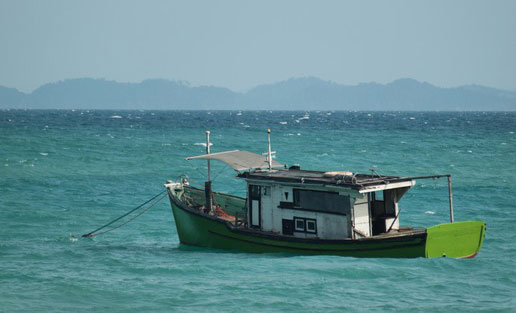
Now that ASEAN countries and China have just started the COC process, it is important for all the participating parties to address the loopholes of the DOC when they discuss and negotiate the COC.
What Does the DOC Process Tell?
Member states of ASEAN and China signed the DOC in November 2002 in Cambodia after several years of prolonged negotiations. The DOC, in the views of many analysts, was essentially a compromise between the two positions of doing nothing and having a legally- binding agreement. The text of the DOC clearly reveals three purposes: promoting confidence-building measures, engaging in practical maritime cooperation, and setting the stage for the discussion and conclusion of a formal and binding COC.
Some observers believe that the DOC has not been a total failure. As the embodiment of political goodwill of all parties, the DOC has, by and large, helped maintain the overall stability in the South China Sea. It has served as a platform for all disputant parties to communicate and exchange views. Some believe that the DOC at least has served as a moral constraint on all claimant states in the South China Sea. They further argue that the DOC has actually contributed to several cases of cooperation in the South China Sea: the tripartite joint seismic study among China, Vietnam, and the Philippines from 2005 to 2008.
Most analysts, however, are disappointed by the lack of efficacy of the DOC in fulfilling all the three purposes. So far, not a single claimant state strictly abided by the DOC, even though the violations of the clauses in the DOC varied from country to country. After the conclusion of the DOC, only very few instances of bilateral or multilateral cooperative projects took place in the South China Sea. And before 2011, the talks on a code of conduct have been slow and not very fruitful.
There were a few reasons to account for these failures. Many analysts believe that the DOC itself was intrinsically flawed because it did not have the legal power to restrain any claimant party’s behaviour in the South China Sea. The DOC lacked the mechanism to monitor, let alone enforce, compliance. Some argue that China did not have much interest in the DOC process and did not intend to implement the DOC lest it jeopardize its sovereignty claims in the South China Sea. More specifically, it is believed that China was not enthusiastic in pushing for cooperation in the South China Sea because China was unhappy with the informal consultation among the four ASEAN claimant states prior to the ASEAN-China meeting on the DOC cooperation. Furthermore, one can argue that the relatively stable situation in the South China Sea before 2008 gave little incentive for the claimant parties, individually or collectively, to take serious steps to implement the DOC.
The text of the DOC provided little information on the specific implementation of confidence-building measures and other forms of cooperation in the South China Sea. The understanding at that time was that all the relevant parties would have to follow up with further discussion on the scope, specific modalities, and policy measures to push for cooperation.
In the first few years after the DOC was signed, ASEAN countries and China did attempt to engage in maritime cooperation. In 2003, they decided to convene regular ASEAN-China Senior Officials’ Meeting (SOM) to oversee the implementation of the DOC and set up a joint working group to handle the specifics. In December 2004, in Kuala Lumpur, the first SOM on the DOC was convened and the parties decided to set up a joint working group mechanism to discuss the implementation of the DOC. They also produced a document that specified the formation, function, and responsibilities of the joint working group. The working group was tasked to study and provide specific policy measures for the implementation of the DOC, as well as identify actions that caused dispute complication or escalation. It was expected to nominate experts who could provide technical support or policy recommendations too. It should meet at least biannually and present its report to the SOM after each meeting. Areas of cooperation include marine environmental protection, marine scientific research, safe maritime navigation, search and rescue and anti-transnational crime operations.
The first joint working group meeting was held in Manila during August 4-5, 2005. ASEAN proposed a draft document of seven-point guidelines for the implementation of the DOC. The second point states, “ASEAN will continue its current practice of consulting among themselves before meeting China.” China objected to this point, arguing that the South China Sea does not concern the whole ASEAN, but only a few ASEAN countries. Thus, China stated that it preferred to discuss with the “relevant parties” in ASEAN, not ASEAN collectively. The difference on this formality issue clouded all subsequent meetings. At the second joint working group meeting held in Sanya in 2006, a breakthrough was apparent: All the parties agreed to focus on six areas of cooperation.
ASEAN and China eventually decided to conclude the DOC implementation guidelines in July 2011 at the China-ASEAN Foreign Ministers’ Meeting. Both sides made concessions on the ASEAN unity issue. At the November 2011 ASEAN-China Summit, China’s former premier, Wen Jiabao, said that China would continue to be a good neighbour, good friend and good partner of ASEAN. He stated that China was willing to work with ASEAN countries towards a comprehensive implementation of the DOC. He added that China was also willing to discuss the drafting of a COC. Wen also pledged to provide US$10 billion in loans (including US$4 billion preferential loans) for infrastructure projects in ASEAN countries.
From late 2011 to mid-2012, ASEAN senior officials worked on drafting a document that outlined the major elements of the future COC. As the ASEAN countries worked on this draft without the direct participation of China, China was unhappy about it but did not openly protest against the apparent act of ASEAN solidarity. At the July 2012 ASEAN Foreign Ministers’ Meeting in Phnom Penh, when ASEAN presented the document that contained the major elements of the COC to China, China still expressed its willingness to engage with ASEAN to start the COC process.
While Beijing is not opposed to the launch of the negotiations of the COC, former Chinese foreign minister, Yang Jiechi, emphasized that the COC discussions may be based on full compliance of the DOC by all parties. He added, “China hopes that all parties will do more to enhance mutual trust, promote cooperation, and create necessary conditions for the formulation of COC.” 1
In August 2013, China’s new foreign minister Wang Yi proposed four views on the COC process. First, it will take a fairly long time to conclude the COC because of the complexities of the issue. Second, the process should observe maximum consensus and respect the comfort level of each claimant party. Third, other interferences should be avoided. Fourth, negotiations should proceed in a gradual manner. Basically, the COC process should go hand in hand with the implementation of the DOC.
On September 15, 2013, the first China-ASEAN Senior Officials’ Meeting on the COC was convened in Suzhou. All parties agreed to start the COC process on the principles of observing consensus and adopting a gradual approach. For sure, the COC process will be significantly delayed or laborious, contrary to the expectations of many regional states and external powers such as the United States.

What Can the COC Learn from the DOC?
The shortcomings of the DOC process are many. First, it is unfortunate that from the late 1990s to 2002, the negotiating parties succumbed to the temptation to compromise in order to conclude a non-legally binding document. As a result, compliance by all parties could only be sustained through political goodwill. But, political goodwill could easily diminish under different domestic and external circumstances. The absence of legal binding force also implies a lack of coordination among claimant parties’ various domestic agencies. This has also been the source of disputes and tensions in the South China Sea in the past years.
The DOC does not stipulate any penalty or cost for non-compliance. There is even no mechanism to inflict rhetorical or reputational damage to the non-compliant party. Instead of observing the DOC, claimant states seem to be competing with one another in violating the spirit of the DOC.
As the DOC does not specify the geographical coverage of the articles, it is not clear which geographical area is covered. Thus, claimant states always argued that their actions in the South China Sea take place in their own undisputed maritime zones. In addition to the ambiguity in geographical coverage, the absence of identification of specific actions as non-compliance has further complicated the implementation of the DOC. Claimant parties scramble to take unilateral actions in the South China Sea fearing that another party’s actions would jeopardize their own claims and interests, particularly when non-compliance does not result in any penalty or cost.
The process of carrying out some of the cooperative projects enshrined in the DOC has been greatly slow. It is clear from the analyses above that some ASEAN countries’ insistence on “ASEAN unity” versus China has partly impeded the initiation of these projects. Also, incessant law enforcement disputes among various claimant states have impeded cooperation in those functional areas.
From 2002 to 2009, it seems that external powers were not actively involved in the South China Sea issue. There was a certain degree of aloofness among external actors as the overall situation in the South China Sea remained largely tranquil during those years. Starting from 2009, extra-regional powers seemed to have stepped up their efforts in the management of the security dispute in the South China Sea. It also seems that their involvement have exerted pressure on various parties in the dispute to accelerate the implementation of the DOC.
From the DOC process, it is probably reasonable to conclude that the COC process will not be an easy one. Very likely, there will be tough negotiations on the drafting of the COC. And there are reasons to believe that even the COC may not suffice to safeguard peace and stability in the South China Sea, let alone resolve the dispute.
But fortunately, various claimant parties, over the decades, have developed or have openly agreed on some principles and norms for the management of the South China Sea dispute. These principles are well-illustrated in the DOC and other ASEAN-China documents. All parties have subscribed to the principle of peaceful settlement of the dispute. They have agreed to abide by the UNCLOS and other relevant international laws in handling and settling the dispute. They agreed to pursue a bilateral approach when the disputed area concerns only two countries; a multilateral approach if the dispute involves more than two countries. Despite constant skirmishes and bickering, claimant states seem to be willing to work together to manage the dispute.
Conclusion
It remains to be seen how fast the COC process could progress and how effective the new document could restrain the actions of claimant parties. For the sake of long-term peace and stability in the South China Sea, it is important that the COC achieves effectiveness in ensuring that relevant parties exercise self-restraint, promote confidence-building measures, and implement cooperative activities in non-sensitive areas. For the COC to be effective, the shortcomings of the DOC and several factors that delayed the implementation of the DOC need to be overcome.
Mingjiang Li
Dr. Mingjiang Li is an Associate Professor at the S. Rajaratnam School of International Studies (RSIS)
Nanyang Technological University, Singapore
Kyoto Review of Southeast Asia. Issue 15 (March 2014). The South China Sea
Notes:
- http://www.china.org.cn/world/2012-07/13/content_25897836.htm. Accessed January 2014 ↩
